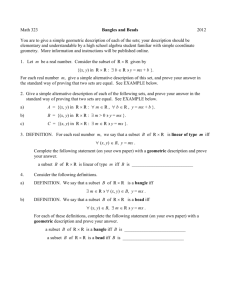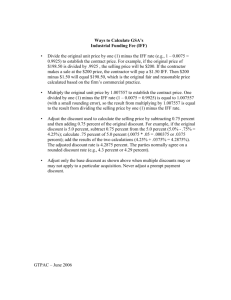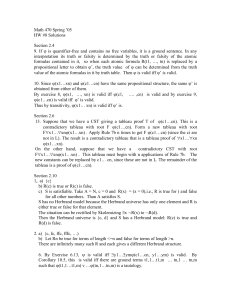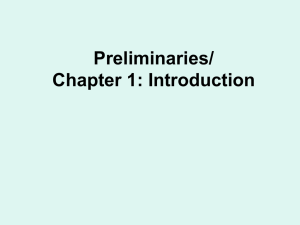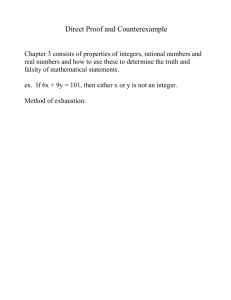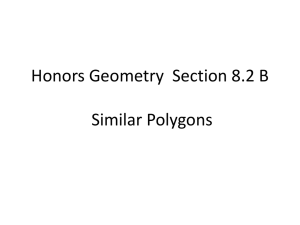PRECISE LIMITS OF FUNCTIONS AS X APPROACHES A CONSTANT
advertisement
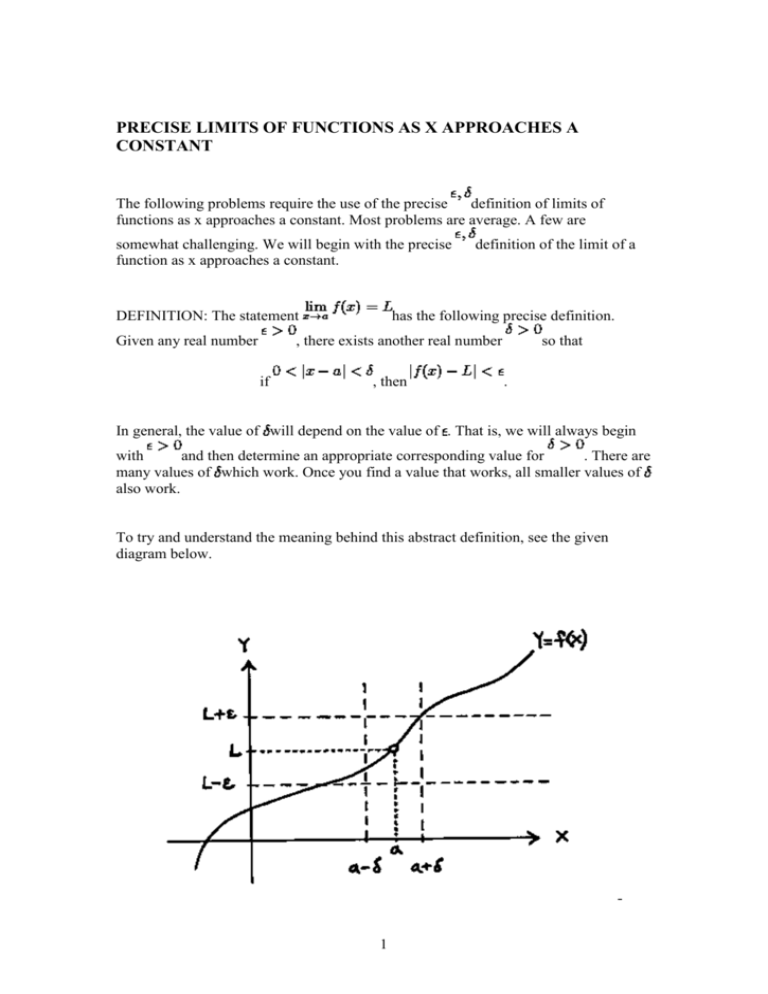
PRECISE LIMITS OF FUNCTIONS AS X APPROACHES A
CONSTANT
The following problems require the use of the precise
definition of limits of
functions as x approaches a constant. Most problems are average. A few are
somewhat challenging. We will begin with the precise
function as x approaches a constant.
DEFINITION: The statement
Given any real number
definition of the limit of a
has the following precise definition.
, there exists another real number
if
, then
so that
.
In general, the value of will depend on the value of . That is, we will always begin
with
and then determine an appropriate corresponding value for
. There are
many values of which work. Once you find a value that works, all smaller values of
also work.
To try and understand the meaning behind this abstract definition, see the given
diagram below.
1
We first pick an band around the number L on the y-axis . We then determine a band
around the number a on the x-axis so that for all x-values (excluding x=a ) inside the
band, the corresponding y-values lie inside the band. In other words, we first pick a
prescribed closeness ( ) to L . Then we get close enough ( ) to a so that all the
corresponding y-values fall inside the band. If a
can be found for each value of
, then we have proven that L is the correct limit. If there is a single
for
which this process fails, then the limit L has been incorrectly computed, or the limit
does not exist.
In the problems that follow, we will use this precise definition to mathematically
PROVE that the limits we compute algebraically are correct. When using this
definition, begin each proof by letting
be given. Then take the expression
and, from this, attempt to algebraically ``solve for" | x - a | . At that
point, an appropriate value for
can easily be determined.
The expression `` iff " will be used often in the solutions to the following problems. It
means `` if and only if " or `` is equivalent to ''. The expression `` min{A, B }" will
also be used in many of the solutions. It means `` the minimum value of A and B."
For example, min{ 3, 7 } = 3.
SOLUTIONS TO LIMITS OF FUNCTIONS USING THE PRECISE
DEFINITION OF LIMIT
SOLUTION 1 :
Prove that
. Begin by letting
, then
be given. Find
, i.e.,
, i.e.,
so that if
. But this trivial
inequality is always true, no matter what value is chosen for . For example,
will work. Thus, if
completes the proof.
, then it follows that
2
. This
SOLUTION 2 : Prove that
. Begin by letting
(which depends on ) so that if
with
, then
be given. Find
. Begin
and ``solve for" |x-10| . Then,
iff
iff
iff
iff
iff
.
Now choose
. Thus, if
completes the proof.
, it follows that
SOLUTION 3 : Prove that
. Begin by letting
(which depends on ) so that if
with
, then
and ``solve for"
. Then,
iff
iff
iff
iff
iff
iff
.
3
. This
be given. Find
. Begin
Now choose
. Thus, if
, it follows that
. This completes the proof.
SOLUTION 4 : Prove that
. Begin by letting
(which depends on ) so that if
be given. Find
, then
. Begin with
and ``solve for" |x-1| . Then,
iff
iff
iff
iff
.
We will now ``replace" the term |x+1| with an appropriate constant and keep the term
|x-1| , since this is the term we wish to ``solve for". To do this, we will arbitrarily
assume that
(This is a valid assumption to make since, in general, once we find a
that works, all smaller values of also work.) . Then
implies that -1 <
x-1 < 1 and 0 < x < 2 so that 1 < |x+1| < 3 (Make sure that you understand this step
before proceeding.). It follows that (Always make this ``replacement" between your
last expression on the left and . This guarantees the logic of the proof.)
iff
iff
.
Now choose
(This guarantees that both assumptions made about in
the course of this proof are taken into account simultaneously.). Thus, if
, it follows that
. This completes the proof.
4
SOLUTION 5 : Prove that
. Begin by letting
(which depends on ) so that if
with
, then
be given. Find
. Begin
and ``solve for" | x - (-1) | = | x + 1 | . Then,
iff
iff
iff
iff
.
We will now ``replace" the term |x-1| with an appropriate constant and keep the term
|x+1| , since this is the term we wish to ``solve for". To do this, we will arbitrarily
assume that
(This is a valid assumption to make since, in general, once we find a
that works, all smaller values of also work.). Then
implies that -1 <
x+1 < 1 and -2 < x < 0 so that 1 < |x-1| < 3 (Make sure that you understand this step
before proceeding.). It follows that (Always make this ``replacement" between your
last expression on the left and . This guarantees the logic of the proof.)
iff
iff
.
Now choose
(This guarantees that both assumptions made about in
the course of this proof are taken into account simultaneously.). Thus, if
, it follows that
proof.
5
. This completes the
SOLUTION 6 : Prove that
. Begin by letting
(which depends on ) so that if
with
be given. Find
, then
. Begin
and ``solve for" | x - 2 | . Then,
iff
iff
iff
.
We will now ``replace" the term |3x+5| with an appropriate constant and keep the term
|x-2| , since this is the term we wish to ``solve for". To do this, we will arbitrarily
assume that
(This is a valid assumption to make since, in general, once we find a
that works, all smaller values of also work.) . Then
implies that -1 <
x-2 < 1 and 1 < x < 3 so that 8 < |3x+5| < 14 (Make sure that you understand this step
before proceeding.). It follows that (Always make this ``replacement" between your
last expression on the left and . This guarantees the logic of the proof.)
iff
iff
.
Now choose
(This guarantees that both assumptions made about in
the course of this proof are taken into account simultaneously.). Thus, if
, it follows that
SOLUTION 7 : Prove that
. This completes the proof.
. Begin by letting
(which depends on ) so that if
with
, then
and ``solve for" | x - 3 | . Then,
6
be given. Find
. Begin
iff
iff
iff
iff
iff
iff
iff
iff
.
We will now ``replace" the term |x+3| with an appropriate constant and keep the term
|x-3| , since this is the term we wish to ``solve for". To do this, we will arbitrarily
assume that
(This is a valid assumption to make since, in general, once we find a
that works, all smaller values of also work.) . Then
implies that -1 <
x-3 < 1 and 2 < x < 4 so that 5 < |x+3| < 7 and
(Make sure that you
understand this step before proceeding.). It follows that (Always make this
``replacement" between your last expression on the left and . This guarantees the
logic of the proof.)
iff
iff
7
iff
.
Now choose
(This guarantees that both assumptions made about in
the course of this proof are taken into account simultaneously.). Thus, if
, it follows that
. This completes the proof.
SOLUTION 8 : Prove that
. Begin by letting
(which depends on ) so that if
be given. Find
, then
Begin with
Then,
and ``solve for" | x - (-6) | = | x + 6 | .
iff
iff
iff
iff
iff
iff
iff
8
.
iff
.
We will now ``replace" the term |2-x| with an appropriate constant and keep the term
|x+6| , since this is the term we wish to ``solve for". To do this, we will arbitrarily
assume that
(This is a valid assumption to make since, in general, once we find a
that works, all smaller values of also work.) . Then
implies that -1 <
x+6 < 1 and -7 < x < -5 so that 7 < |2-x| < 9 and
(Make sure that you
understand this step before proceeding.). It follows that (Always make this
``replacement" between your last expression on the left and . This guarantees the
logic of the proof.)
.
iff
.
iff
iff
.
Now choose
(This guarantees that both assumptions made about in
the course of this proof are taken into account simultaneously.). Thus, if
, it follows that
. This
completes the proof.
SOLUTION 9 : Prove that
. Begin by letting
(which depends on ) so that if
, then
and ``solve for" | x - 3 | . Then,
iff
9
be given. Find
. Begin with
iff
iff
iff
iff
iff
iff
.
We will now ``replace" the term | 4x-9 | with an appropriate constant and keep the
term |x-3| , since this is the term we wish to ``solve for". To do this, we will arbitrarily
assume that
(This is a valid assumption to make since, in general, once we find a
that works, all smaller values of also work.) . Then
implies that -1 <
x-3 < 1 and 2 < x < 4 . HOWEVER, THIS RANGE OF X-VALUES IS NOT
APPROPRIATE SINCE THE FUNCTION
IS NOT DEFINED AT
! Fortunately, this problem can be easily resolved. We simply pick small
enough to avoid
implies that
. For example, assume that
and
. Then
so that 2 < | 4x-9 | < 4 and
(Make sure that you understand this step before proceeding.). It
follows that (Always make this ``replacement" between your last expression on the
left and . This guarantees the logic of the proof.)
.
iff
10
iff
iff
.
Now choose
(This guarantees that both assumptions made about in
the course of this proof are taken into account simultaneously.). Thus, if
, it follows that
. This completes the proof.
SOLUTION 10 : Prove that
. Begin by letting
(which depends on ) so that if
be given. Find
, then
and ``solve for" | x - 9 | . Then,
iff
iff
(At this point, we need to figure out a way to make | x-9 | ``appear'' in our
computations. Appropriate use of the conjugate will suffice.)
iff
(Recall that
.)
iff
iff
.
iff
.
11
. Begin with
We will now ``replace" the term
with an appropriate constant and keep the
term |x-9| , since this is the term we wish to ``solve for". To do this, we will arbitrarily
assume that
(This is a valid assumption to make since, in general, once we find a
that works, all smaller values of also work.) . Then
implies that -1 <
x-9 < 1 and 8 < x < 10 so that
and
(Make sure that you understand this step before
proceeding.). It follows that (Always make this ``replacement" between your last
expression on the left and . This guarantees the logic of the proof.)
iff
iff
.
Now choose
(This guarantees that both assumptions made
about in the course of this proof are taken into account simultaneously.). Thus, if
, it follows that
. This completes the proof.
SOLUTION 11 : Prove that
. Begin by letting
(which depends on ) so that if
be given. Find
, then
and ``solve for" | x - 4 | . Then,
iff
(At this point, we need to figure out a way to make | x-4 | ``appear'' in our
computations. Appropriate use of the conjugate will suffice.)
iff
(Recall that
.)
12
. Begin with
iff
iff
iff
iff
.
We will now ``replace" the term
with an appropriate constant and keep
the term |x-4| , since this is the term we wish to ``solve for". To do this, we will
arbitrarily assume that
(This is a valid assumption to make since, in general,
once we find a that works, all smaller values of also work.) . Then
implies that -1 < x-4 < 1 and 3 < x < 5 so that
and
(Make sure that you understand this step before
proceeding.). It follows that (Always make this ``replacement" between your last
expression on the left and . This guarantees the logic of the proof.)
iff
iff
.
Now choose
(This guarantees that both assumptions made
about in the course of this proof are taken into account simultaneously.). Thus, if
, it follows that
. This completes the proof.
13
SOLUTION 12 : Prove that
. Begin by letting
(which depends on ) so that if
be given. Find
, then
. Begin with
and ``solve for" | x - 1 | . Then,
iff
iff
iff
iff
iff
(At this point, we need to figure out a way to make | x-1 | ``appear'' in our
computations. A simple use of constants will get us started.)
iff
iff
iff
(We need to be able to factor (x-1) from the numerator. Apply the conjugate to the
term
.)
iff
iff
14
iff
iff
(Now get a common denominator.)
iff
iff
iff
iff
iff
.
We will now ``replace" the terms
and
with appropriate constants
and keep the term |x-1| , since this is the term we wish to ``solve for". To do this, we
will arbitrarily assume that
(This is a valid assumption to make since, in general,
once we find a that works, all smaller values of also work.). Then
implies that -1 < x-1 < 1 and 0 < x < 2 so that
. In addition,
so that
and
(Make sure that you understand these steps before
proceeding.). It follows that (Always make this ``replacement" between your last
expression on the left and . This guarantees the logic of the proof.)
iff
iff
.
15
Now choose
(This guarantees that both assumptions made about in the
course of this proof are taken into account simultaneously.). Thus, if
it follows that
. This completes the proof.
SOLUTION 13 : Prove that
. Begin by letting
(which depends on ) so that if
with
,
, then
be given. Find
. Begin
and ``solve for" | x - a | . Then,
iff
.
At this point, we need to figure out a way to introduce the term | x-a | into our
computations. The answer lies with the Mean Value Theorem. Consider the function
on the interval [A, B] . Since f is continuous on the closed interval [A, B]
and differentiable (
) on the open interval (A, B) , according to the Mean
Value Theorem there is at least one number C , A < C < B , satisfying
,
i.e.,
.
Then
so that
.
This is true for any two real numbers, A and B . It follows that (Always make this
``replacement" between your last expression on the left and . This guarantees the
logic of the proof.)
.
16
Now choose
. Thus, if
completes the proof.
, it follows that
SOLUTION 14 : Prove that
. Begin by letting
(which depends on ) so that if
with
. This
be given. Find
, then
. Begin
and ``solve for" | x - a | . Then,
iff
.
At this point, we need to figure out a way to introduce the term | x-a | into our
computations. The answer lies with the Mean Value Theorem. Consider the function
on the interval [A, B] , where A and B are both positive. Since f is
continuous on the closed interval [A, B] and differentiable (
) on the open
interval (A, B) , according to the Mean Value Theorem there is at least one number C ,
A < C < B , satisfying
,
i.e.,
.
Then, since 0 < A < C < B , it follows that
, so that
.
Thus,
(*)
.
This is true for any two positive real numbers A and B , where B > A . At this point,
we need to consider two cases.
17
If x > a , it follows from inequality (*) that (Always make this ``replacement"
between your last expression on the left and . This guarantees the logic of the proof.)
iff
iff
Now choose
.
. Thus, if
, it follows that
If x < a , then it is reasonable to assume that
as x approaches a . Thus,
.
since we are considering the limit
and it follows from inequality (*) that
so that
iff
iff
.
Now choose
. Thus, if
completes the proof.
, it follows that
SOLUTION 15 : Let
. Prove that
18
. This
does not exist .
ASSUME THAT THE LIMIT DOES EXIST. That is, assume that
,
where L is some real number. It follows that for EACH real number
another real number
, there exists
so that
if
, then
.
We will proceed to find ONE
for which NO
works. THIS WILL BE A
CONTRADICTION OF OUR ASSUMPTION, making our assumption false, proving
that the limit does not exist. (This method is called proof by contradiction.)
By looking at the graph of f , which is given above, we see that x-values chosen
``near'' to x=1 but on opposite sides of x=1 have corresponding y-values which are
``about'' one unit apart. Intuitively, this tells us that the limit does not exist and leads
us to choose an appropriate
Consider
some number
leading to the above contradiction.
. Under our assumption that the limit does exist, it follows that there is
so that if
, then
. But for ANY
choice of
iff
(and x not equal to 1)
19
iff
Thus, both
and
(and x not equal to 1) .
satisfy
, which implies that
and
.
In addition,
= | -1 |
=1.
Now, by the triangle inequality
=1.
We have just concluded that
,
an obvious contradiction. It must be that the original limit does not exist.
20



